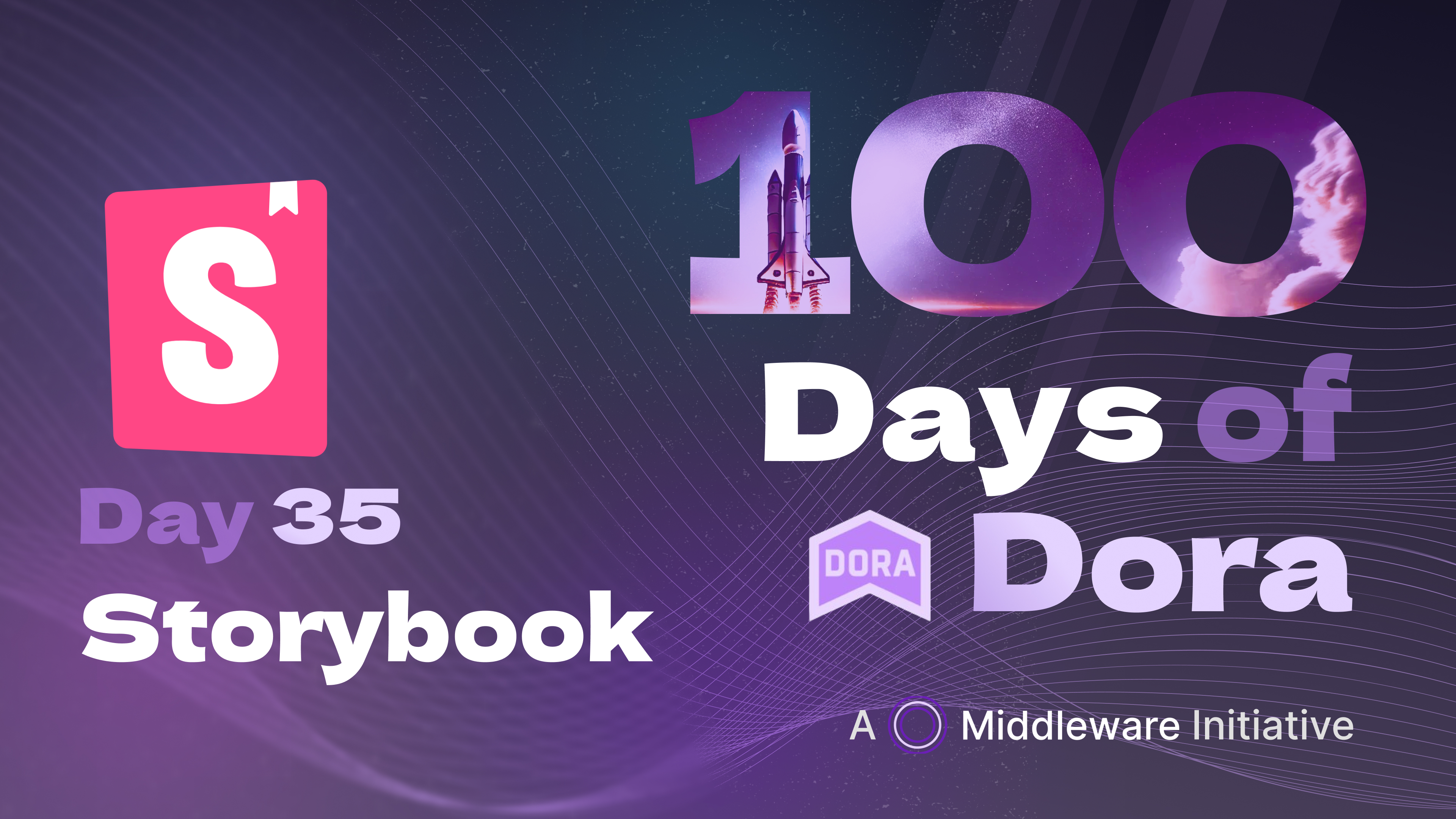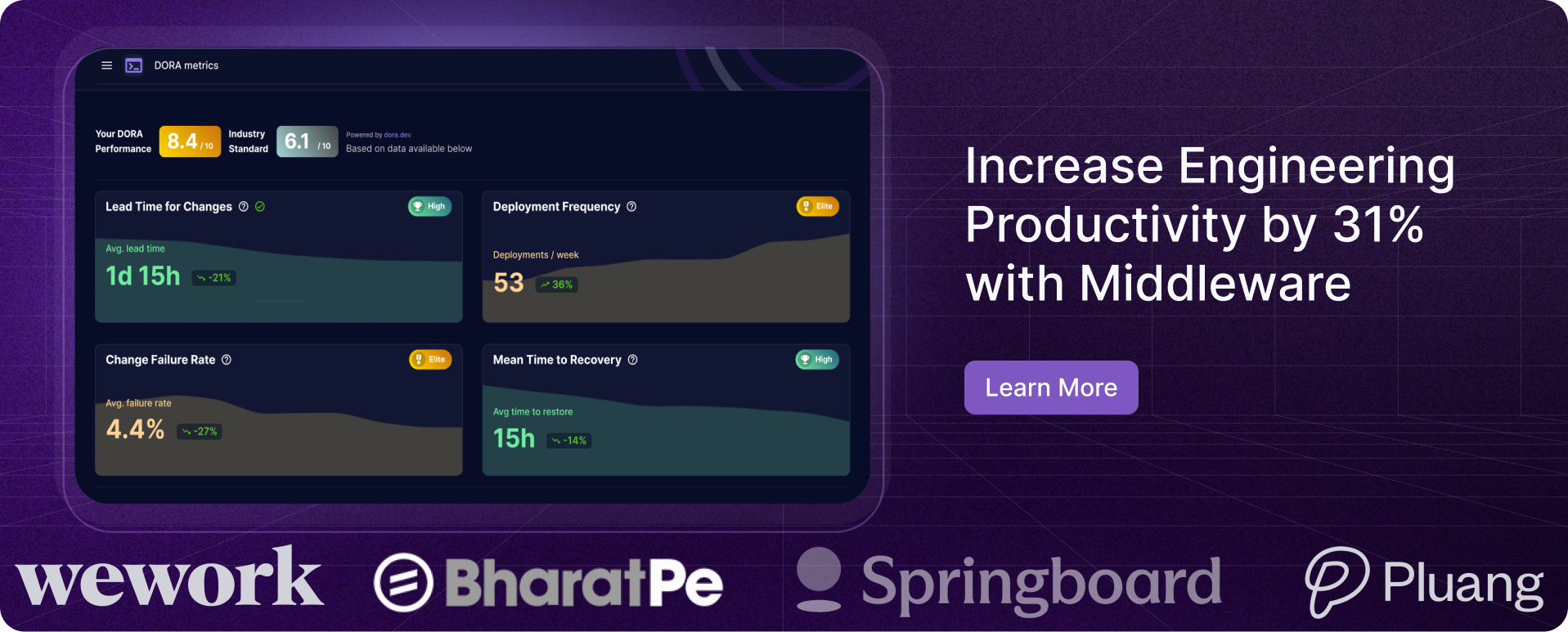Storybook Dora Metrics: Crafting a Success Story with Impressive PR Merges; Cycle Time Raises Red Flags
 Rajni Rethesh
Rajni Rethesh
Are you building an app or a website user interface? Wish to toy around with some cool UI components without affecting the entire front end?
Have you tried Storybook?
Storybook is a cool tool in the modern web development landscape that helps you create and test your UI elements in their own little world, making sure everything looks and behaves just right before throwing it into the big mix.
Storybook is an open-source tool and has around 2k contributors actively contributing to offer the best tools to make the front-end development process easy.
So, let’s dive in and see how Storybook is managing their engineering pipeline to push out all these cool, little components that make a developer’s life a breeze. Using Middleware OSS, I get down to checking their Dora Metrics, and let’s see what I found. You can read about Dora Metrics in detail here
Also read: What Are DORA Metrics & How They Can Help Your Software Delivery Process
Tracking Team Storybook Dora Metrics: Efforts, Achievements, and Areas for Improvement
Over the past few months, the work on this project has been neatly divided into different categories, each playing a key role in pushing things forward.
A solid 25% of the effort went into polishing and updating documentation—because good docs are the backbone of any project. For instance, Kasper Peulen, one of their key contributors played a big part here, dedicating his efforts to making sure everything is crystal clear and user-friendly.
Bug fixes took the lead with 35%, keeping things stable and smooth.
Feature enhancements weren’t far behind at 30%, showing the team’s commitment to evolving the project.
The remaining 10%? That went into testing and miscellaneous tasks, ensuring everything runs perfectly. One of their other major contributors, Valentin Palkovic, focused on integrating robust testing utilities into their process workflow.
What was the result of their efforts?
Let’s check.
Team Storybook maintained an absolutely perfect first response, merge, rework time - all within 1 day. In Particular, they maintained an incredible rework time of around 1 hour.
Also, they merged around 205, 102, and 70 PRs in the months of July, August, and September, showing a healthy and consistent throughput of contributions that highlights their capacity to handle a large volume of PRs efficiently.
However, their cycle time was way over the standard benchmark laid down by the 2023 State of DevOps Report.
🚨 Sound the Alarms! Storybook’s Cycle Time is Out of Control! 🚨
Their cycle time that started as a hefty 19.45 days in July spiraled into a whopping 26.1 days in August, only to hit an eye-watering 31.31 days by September 2024!
That’s nearly a month just to push a change through! If cycle times were a race, Storybook just lapped itself... but in slow motion.
This isn't just a minor hiccup—it’s a full-blown productivity bottleneck waving red flags! The longer a PR sits in limbo, the harder it becomes to maintain momentum, squash bugs, and deliver those shiny new features users crave. If things don’t get sorted soon, Storybook’s dev cycle might start resembling a never-ending Netflix binge: too slow, too long, and way overdue!
Also read: VS Code Dora Metrics: Reveals Smooth Cycle Time Smooth; Raises Red Flags on Lead Time
Despite having a great first response, merge, and rework times, their cycle time showed a disappointing trend.
Why?
Volatility in Contributions
Storybook showed significant fluctuations in the weekly and monthly pull request (PR) merges. This reveals how unpredictable contribution patterns can strain the overall process.
During periods of high activity (remember a lot of activities are happening around feature enhancements, bug fixes, and documentation), the team might be flooded with PRs, leading to rushed responses and a potential backlog.
Resource Allocation Challenges
Managing cycle times in an open-source environment, where contributors are often volunteers, presents unique difficulties. Volunteers, unlike full-time employees, juggle their contributions with other responsibilities, making resource allocation a constant challenge. This unpredictability can significantly impact cycle time of an engineering pipeline, especially when the available workforce doesn’t match the demand.
Leveraging their Strengths to Smoothen the Engineering Workflow
To improve cycle time, the project can leverage its existing strengths in the following ways:
Amplify Automated Review Workflows
With a strong contributor community of around 2,000 and successful automated review workflows in place (as seen in PRs like #29187 and #29081), the team can further automate more aspects of the review process.
This could include automating additional checks for coding standards, security vulnerabilities, or even minor style fixes. By offloading these tasks to automated tools, contributors and maintainers can focus on the more complex parts of the review, accelerating the overall cycle time.
Optimize CI/CD Integration for Faster Feedback
Their seamless CI/CD pipelines already provide quick feedback on code changes, which is essential for fast PR merges. To further reduce cycle time, they can analyze the bottlenecks within the CI/CD process and optimize them—perhaps by parallelizing more tests or optimizing test suites for speed. Faster feedback loops mean developers can address issues more quickly, reducing the overall time from PR submission to merge.
Increase Engagement of Core Maintainers
With active engagement from maintainers like Valentin Palkovic and Kasper Peulen, combined with automation support, they can further enhance their impact by scheduling dedicated review hours or "merge sprints."
By doing this, they can clear any PR backlogs that slow down cycle time, ensuring that the review process doesn't remain on hold when the human touch is needed.
Additionally, assigning contributors with specific roles for handling different stages (review, testing, merge) can make the process more efficient.
Utilize Contributor Community More Effectively
With a robust community of 2,000 contributors, the project can better distribute the workload by empowering more trusted contributors to handle preliminary reviews or low-priority PRs. By delegating these tasks, core maintainers can focus on high-impact PRs that need more attention, reducing overall cycle times and maintaining a steady flow of merges.
Storybook Dora Metrics: Crafting a Success Story with Impressive PR Merges
Storybook’s ability to merge a significant number of PRs—205, 102, and 70 in the past three months—demonstrates their strength in handling contributions effectively. Their responsive community, automated workflows, and CI/CD integration keep things moving smoothly. However, their cycle time lags behind, mainly due to unpredictable contribution patterns and volunteer-based resource challenges. By maximizing automation, streamlining CI/CD feedback, and better distributing tasks across their vast contributor base, Storybook can close the gap and achieve both high merge rates and shorter cycle times.
If you are looking to craft success stories in your software delivery journey, then write to us at productivity@middlewarehq.com and we would be happy to help you provide actionable insights into your workflow or you can also try tracking your Dora metrics yourself using Middleware Open Source that too for free!
Did you know?
Since its launch, Storybook has gained immense popularity, with over 200,000 developers worldwide using it to streamline their UI development process.
Further Resources
Subscribe to my newsletter
Read articles from Rajni Rethesh directly inside your inbox. Subscribe to the newsletter, and don't miss out.
Written by

Rajni Rethesh
Rajni Rethesh
I'm a senior technical content writer with a knack for writing just about anything, but right now, I'm all about technical writing. I've been cranking out IT articles for the past decade, so I know my stuff. When I'm not geeking out over tech, you can catch me turning everyday folks into fictional characters or getting lost in a good book in my little fantasy bubble.
